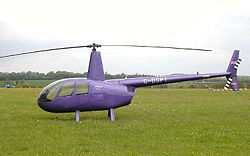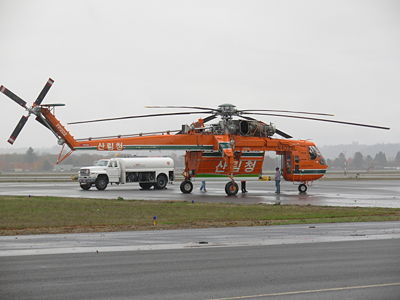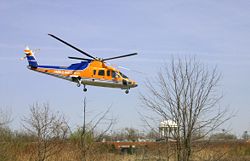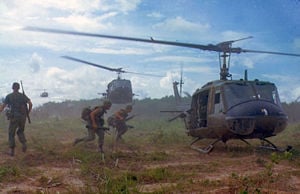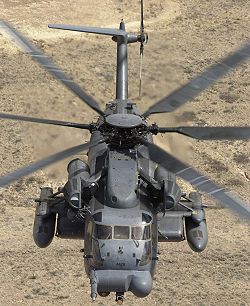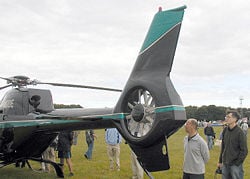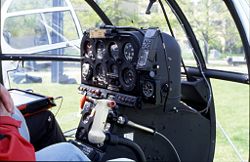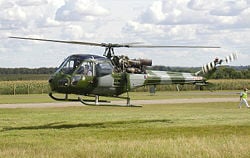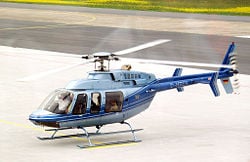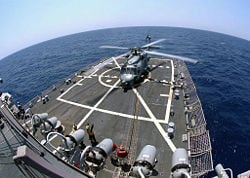Helicopter
A helicopter is an aircraft that is lifted and propelled by one or more horizontal rotors—each of which comprises two or more rotor blades. Helicopters are classified as rotary-wing aircraft to distinguish them from fixed-wing aircraft (or airplanes). The word "helicopter" derives from the Greek words helix (spiral) and pteron (wing).
Compared to fixed-wing aircraft, helicopters are much more maneuverable. They can hover, take off and land vertically, and fly in reverse or to the side. Their range is subject only to availability of a refueling site and limitations of load and altitude. In principle, helicopters can fly anywhere and land any place with enough space (about twice the rotor disc area). Helicopters gain these advantages at the cost, in comparison to fixed-wing aircraft, of greater mechanical complexity, greater cost to buy and operate, and less speed, range, and payload capability.
In contrast with the other primary operational vertical-lift aircraft—the tiltrotor (V-22 Osprey) and the vertical take-off and landing (VTOL) jet (AV-8 Harrier), both of which are specially designed and used strictly for military applications, helicopters are designed and used for a wide variety of civilian and commercial applications as well. They include search and rescue, emergency medical service, firefighting, commercial aviation, executive transportation, aerial photography, media reporting, servicing oil rigs, patrolling borders, and surveying mineral resources for development.
For more densely populated countries, passenger helicopters are viewed as a possibly more efficient means of transportation compared to fixed-wing commuter aircraft. Some predict that passenger helicopters can not only revolutionize mass transportation in parts of the world but also improve the quality of life in a country by promoting efficient utilization of its territory.
History
Since 400 B.C.E. the Chinese have had a children's toy that is a bamboo flying top. Eventually, this flying top toy made it to Europe, and is depicted in a 1463 European painting. Pao Phu Tau (抱朴子) was a fourth-century book in China describing some of the ideas inherent to rotary-wing aircraft. Around 1490, Leonardo da Vinci first conceived the semi-practical, manned helicopter.
The word "helicopter" (hélicoptère) was coined in 1861 by Gustave de Ponton d'Amécourt, a French inventor who demonstrated a small, steam-powered model, but it was not until after the invention of the powered airplane in the twentieth century that helicopters were actually manufactured. Aircraft developers Jan Bahyl, Oszkár Asbóth, Louis Breguet, Paul Cornu, Traian Vuia, Emile Berliner, Ogneslav Kostovic Stepanovic, and Igor Sikorsky pioneered this type of aircraft.
In 1907, the French inventor Paul Cornu made a helicopter that used two 20-foot (six-meter) counter-rotating rotors driven by a 24-horsepower (18-kilowatt) Antoinette engine. It lifted its inventor to about five feet (1.5 meters) and remained aloft one minute.
In the 1920s, Raúl Pateras de Pescara demonstrated the first helicopters with cyclic pitch controls.[1] Juan de la Cierva introduced the first, practical autogyro in 1923, the rotary-wing aircraft that became the basis for the modern helicopter.
In 1922, Albert Gillis von Baumhauer, a Dutch aeronautical engineer, started studying the possibilities of VTOL rotor craft. His first prototype flew (hopped and hovered really) on September 24, 1925, with Dutch Army-Air Captain Floris Albert van Heijst at the cyclic (to control horizontal movement) and the collective (to control vertical movement). Both the cyclic and the collective are von Baumhauer inventions for which he was granted by the British Ministry of Aviation on January 31, 1927, under number 265,272.
In 1931, Soviet aeronautical engineers Boris Yuriev and Alexei Cheremukhin began experiments with the TsAGI 1-EA helicopter, which featured a single lifting rotor complemented by forward and aft anti-torque rotors. It reached an altitude of 605 meters (1,984 feet) on August 14, 1932, with Cheremukhin at the controls.
The German Focke-Wulf FW-61 was the first production fully controllable helicopter and had its first flight in 1936. The FW-61 broke all world records in 1937. Nazi Germany used the helicopter in combat during World War II in small numbers. Models such the Flettner FL 282 Kolibri were used in the Mediterranean Sea.
Igor Sikorsky created America's first successful helicopter in 1939.[2] Mass production of the military version of the Sikorsky XR-4 began in May 1942 for the United States Army and was used over Burma for rescue duties.[3] It was also used by the Royal Air Force, the first British military unit to be equipped with helicopters being the Helicopter Training School, formed in January 1945 at RAF Andover with nine Sikorsky R-4B Hoverfly I helicopters.
In March 1946, the Bell 47, designed by Arthur Young, became the first helicopter to be licensed for certified civilian use in the United States. Two decades later, the Bell 206 became the most successful commercial helicopter ever built with more hours and having set more industry records than any other aircraft in the world.
Reliable helicopters capable of stable hover flight were developed decades after fixed-wing aircraft, due largely to the helicopter's need for higher engine power density than is need for fixed wing aircraft. Sikorsky is reported to have delayed his own helicopter research until suitable engines were commercially available. Improvements in fuels and engines during the first half of the twentieth century were a critical factor in helicopter development. The availability of lightweight turboshaft engines in the second half of the twentieth century led to the development of larger, faster, and higher performance helicopters. Turboshaft engines are the preferred powerplant for all but the smallest and least expensive helicopters today.
Uses of Helicopters
Aerial cranes
The ability of large helicopters to lift and hover with heavy loads makes them ideal for placing large objects in otherwise inaccessible locations. In this mode, the heavy load is secured to a long cable or sling by which the helicopter lifts the load and delivers it to the intended destination. Examples include placing transmission towers and large air conditioning units on the tops of tall buildings and raising a radio tower on the top of a hill or mountain, far from the nearest road. The most popular use of helicopters as aerial cranes is in the logging industry for lifting large trees out of terrain that is too rugged for vehicle access, or where environmental concerns prohibit the building of roads.
Aerial photography and news gathering
Helicopters provide both nightly news photos of traffic conditions and movie scenes that were unthinkable before the advent of the helicopter. While small airplanes are also used for taking aerial photos, helicopters offer lower altitudes and areas not accessible to airplanes. Helicopters are often used by news services to observe scenes where newsworthy incidents have occurred. The helicopter can carry a camera to record an aerial view of a scene to be saved for later broadcast or transmitted to a newsroom for live broadcast.
Air ambulance
Many hospitals in the United States have a helicopter landing pad for receiving ambulance helicopters bringing patients to the emergency room. Helicopters are often used for providing emergency medical assistance and patient delivery when a traditional ambulance cannot easily or quickly reach the scene or when a patient needs to be transported further than is practical by surface routes. Air ambulance crews are supplied with equipment that enables them to provide medical treatment to a critically injured or ill patient. The use of helicopters as an air ambulance is sometimes referred to as MEDEVAC, or patients are referred to as being "airlifted," or "medevaced."
Firefighting
Helicopters join with airplanes in fighting forest fires from the air through dropping water on them. Helicopters are especially well-suited for the most rugged terrain. They may be fitted with tanks or carry buckets or deliver firefighters who rappel to the ground below. A bucket suspended by a cable is usually filled by submerging in a lake, river, reservoir, or portable tank. If the helicopter has tanks, they may be filled on the ground or by pumping water from lakes or reservoirs through a hanging snorkel. Helicopters are also used to resupply firefighters on the ground with tools, food, water and other supplies.
Law enforcement
Police departments and other law enforcement agencies use helicopters to search for and pursue suspects. Since helicopters can achieve a unique aerial view and don't need to negotiate ground obstacles, they are often used in conjunction with police on the ground to report on suspects' locations and movements. Police helicopters are often mounted with lighting and heat-sensing equipment for night pursuits.
Military
The greatest use of helicopters is by military services for such purposes as reconnaissance, attack, transport of troops and supplies, and evacuation of wounded personnel. One aftermath of the Vietnam War was the large pulse of experienced helicopter pilots who returned to civilian life, sought employment as pilots, and came to play an important role in the expansion of the uses of helicopters.
Oil and gas industry
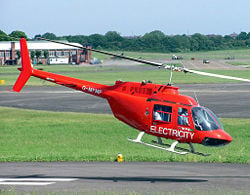
Hundreds of Vietnam War veteran helicopter pilots found employment with the oil and gas industry, the largest non-military user of helicopter services. Helicopters are needed in surveying to locate oil and gas, drilling the wells, and operating them. Whether the oil field is in Alaska, the Gulf of Mexico, the Caspian Sea, Kazakhstan, or Nigeria, helicopters provide the ready access to remote locations that no other mode of transport offers. When the oil rig is 60 miles from shore, the helicopter is the best choice for delivering urgently needed supplies and for maintaining the flow of crew members to and from the rig. It is reasonable to say that without helicopters, oil and gas would be more expensive. Pilots are in such demand that they can work servicing oil rigs in the Gulf of Mexico, live in any of the 48 United States, work one week on and one week off, and have the company pay the airfare for the long weekly commute. Also in the energy sector, power companies use helicopters for surveying routes for new power lines and for monitoring and servicing the completed power lines.
Scheduled passenger transportation
Helicopters have claimed a secure niche in providing charter flight services such as for sightseeing and visiting remote locations. At the same time, helicopters seem to have unrealized potential for flying scheduled passenger transportation routes between sites that are not easily accessible by other means, such as two land areas separated by water, two population centers separated by mountains or an airport separated from the center of a city by congested traffic routes.
Realizing this potential requires, as with any commercial venture, enough paying customers to cover the operating costs with some profit margin. Trains, planes, and boats, the main competitors of helicopters, in most cases start with the advantage of being the incumbent technology with an established customer base and infrastructure. Establishing regular helicopter service against such competition requires that customers choose helicopters after weighing factors of time, cost, comfort, convenience, and safety.
The longest operating scheduled helicopter service has flown since 1964 between the town of Penzance on the Land's End Peninsula at the tip of the United Kingdom's Southwest Province and the Isles of Scilly, 28 miles offshore. The service carries more than 100,000 passengers each year, with up to 40 flights per day during the peak summer season. Other regularly scheduled helicopter services include those running between Macau and the island of Hong Kong, a distance of 40 miles; the cities of Vancouver and Victoria in British Columbia; and population centers in valleys in Arunachal Pradesh, a remote mountainous region in the high Himalayas of northeast India.
In the U.S., the federal government subsidized scheduled helicopter service between the metropolitan airports and city centers of New York, Chicago, and Los Angeles from 1954 through 1966. Those services maintained their unsubsidized existence for several years, but eventually all were closed by the late 1970s. Factors in the closings included not only subtle obstacles related to the preexisting air flight infrastructure being tailored to accommodate fixed-wing aircraft, but also more immediate issues such as rising fuel costs and a tragic, high-profile accident on the top of the Pan Am Building in the center of New York City.[4] The years following the close of the scheduled helicopter services saw the increased use of corporate helicopters transporting executives into and out of the city as they landed on privately owned heliports on the top of buildings and on corporate grounds.
Despite this proliferation of corporate helicopter use, a startup helicopter service company at the end of 2006 and into 2007 scheduled helicopter service connecting JFK and Newark international airports of metropolitan New York City with downtown and midtown Manhattan. The federal government has assisted by installing full international airline security facilities at the two Manhattan heliports so passengers taking international flights can complete their security check-in at the heliport. The level of success of this pioneering second round of commercial helicopter service in New York City, which benefits from thirty years of improvements in helicopter technology, may be decisive in determining the fate of scheduled helicopter service between other city center's and their nearby airport.
Generating lift
The helicopter rotor generates lift according to the same principles as those by which aircraft wings produce lift, but, due the rotor's rotation, coordinating and managing its lift generation is much more challenging than managing lift generation by an aircraft's fixed wings. In conventional aircraft, the shape of the cross-section, or airfoil, of the wing, requires that whenever the wing moves forward through the air the air flowing over the upper surface travels farther and thus faster than the air flowing past the lower surface. The result is a net lift because there is less air pressure on the upper wing surface than on the lower. A helicopter makes use of the same principle, except that instead of moving the entire aircraft, only the wings themselves are moved in a circular motion. The helicopter's rotor can simply be regarded as rotating wings, from where the military name of "rotary-wing aircraft" originates.
As a general rule, moving a wing faster through the air produces greater lift, but it also produces more drag or resistance to the forward motion. In a fixed wing aircraft the increased drag is in balance on both wings because they are both moving through the air at the same velocity. In a forward-moving helicopter, however, one rotor blade moves against the airflow while the other moves with it and the constant rotation introduces further differences between the two blades. Designing, constructing, and controlling the movement of the rotor blades thus becomes a primary consideration for helicopter manufacturers.
Conventional layout
There are several possible layouts for arranging a helicopter's rotors. The most common design is the Sikorsky-layout, which is used by approximately 95 percent of all helicopters manufactured. Turning the rotor generates lift but it also applies a reverse torque, which would spin the helicopter fuselage in the opposite direction to the rotor if no counter force is applied. At low speeds, the most common way to counteract this torque is to have a smaller vertical propeller mounted at the rear of the aircraft called a tail rotor. This rotor creates thrust in the opposite direction from the torque generated by the main rotor. When the thrust from the tail rotor is sufficient to cancel out the torque from the main rotor, the helicopter will not rotate around the main rotor shaft. Almost all civilian helicopters have the main rotor and tail rotor system.
Sometimes the blades of a tail rotor are laid out in an X-shape, which is supposed to reduce the noise levels for military use (e.g. AH-64 Apache). The primary reason is to make the arrangement of the pitch controls simpler. If the tail rotor is shrouded (i.e., a fan embedded in the vertical tail) it is called a fenestron. The fenestron rotor system on the Eurocopter EC120 helicopter uses a shaft driven system and gearbox to turn the fan. It is less efficient but the advantages are that less noise is generated, it is safer for people that may walk near it and, because it is shrouded, there is a smaller chance of the blades being damaged by objects, unlike the traditional tail rotor.
The amount of power required to prevent a helicopter from spinning is significant. A tail rotor typically uses about five to six percent of the engine's power, and this power does not help the helicopter produce lift or forward motion. To reduce this waste during cruise, the vertical stabilizer is often angled to produce a force which helps counter the main rotor torque. At high speeds, it is possible for the vertical stabilizer to counteract the entire torque, leaving more power available for forward flight. This is commonly known as slip-streaming. Another reason for the angled vertical stabilizer is to make it possible to stage a successful high-speed, run-on landing, in case of tail rotor failure or damage.
Many military helicopters, especially attack types, have short wings called stub wings to add lift during forward motion. They are also used as external mounts for weapons. Depending on the design, however, wings can often degrade hovering performance, as they partially obstruct the airflow created by the main rotor.
Alternative layouts
There are alternatives to Sikorsky's layout, which save the weight of a tail boom and rotor. Such designs use two main rotors that turn in opposite directions, or contra-rotate, so that the torques from each rotor cancel each other out. These methods introduce even more mechanical complexity to the design and are usually only used in specialized helicopter types.
The co-axial design, where rotors are mounted on top of each other at the top of the fuselage and share a common main axle complex, was first built by Theodore von Karman and Asbóth Oszkár in 1918 and later became the hallmark of the Soviet Kamov design bureau. Co-axial helicopters in flight are highly resistant to crosswinds, which makes them suitable for shipboard use, even without a rope-pulley landing system.
The slightly different system of intermeshing rotors, also called a “synchropter,” which was developed in Nazi Germany for a small anti-submarine warfare helicopter, the Flettner Fl 282 Kolibri, features two main rotors on separate, obliquely mounted axles. The contra-rotating rotors are on top of the fuselage, close to each other. During the Cold War the American Kaman company started to produce similar helicopters for United States Air Force (USAF) firefighting purposes. Kamans have high stability and powerful lifting capability. The latest Kaman K-Max model is a dedicated sky crane design, used for construction works.
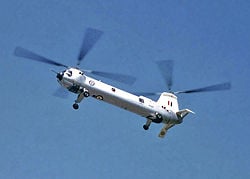
In the flying-wagon or tandem rotors system (sometimes called "flying banana" for the peculiar shape of early U.S. examples), the rotors are located at the front and rear extremity of a long, boxy fuselage that resembles a railway wagon. A prime example is the Boeing CH-47 Chinook, that can carry 14 tons of payload. Wagon helicopters are practical for military logistical purposes, because entry and unloading is easy via the unobstructed front and rear ramps. The rotors and turbines are located very high on top of the fuselage, making them less susceptible to damage and dirt. The main drawback of a tandem rotor is limited agility in air and the need for a highly-trained crew, as the large main rotors have long outreach beyond the fuselage and may easily hit nearby obstacles. In 2001, a South Korean Army CH-47 Chinook crashed into a bridge for that reason.
In the cross system, the rotary-wing aircraft resembles a traditional fixed-wing airplane, with the two main rotors mounted at the extremities of its wings. Such helicopters are rare, because structural integrity of the wings is difficult to maintain against the amplified resonance of far off-board rotor-turbine units. The 1930s German FW-61 helicopter was an example of such a design. The world's largest ever helicopter, the Soviet Mil-V-12 prototype, was a cross of two Mil Mi-6 turbine-rotor units built onto a modified Antonov cargo plane. The U.S. V-22 Osprey tilting rotorcraft is similar, although its nacelles can be rotated, and shares some of the inherent technical problems of a cross system.
A recent development in helicopter technology is the NOTAR system, which stands for NO TAil Rotor. The NOTAR eliminates the tail rotor by conducting high-velocity air through the tail boom, using the Coandă effect to produce forces to counter the torque. NOTARs adjust thrust by opening and closing a sliding circular cover near the end of the tail boom. The NOTAR system was developed in the United States and is used exclusively by McDonnell Douglas Helicopters.
The most unusual design is the roto-rocket principle, where the single main rotor draws power not from the shaft, but from its own wingtip jet nozzles, which are either pressurized from a fuselage-mounted gas turbine or have their own pulsejet combustion chambers. Although this method is simple and eliminates torque, the prototypes that have been built lack the efficiency of conventional helicopters.
Controlling flight
Useful flight requires that an aircraft be controlled in all three dimensions. In a fixed-wing aircraft this is easy: small movable surfaces are adjusted to change the aircraft's shape so that the air rushing past pushes it in the desired direction. In a helicopter, however, there is often not enough speed for this method to be practical.
For pitch (tilting forward and back) or roll (tilting sideways) the angle of attack of the main rotor blades is altered—cycled—during the rotation creating different amounts of lift at different points in the cycle. This is also how the helicopter is propelled: pitching forward causes forward flight.
For rotation about the vertical axis (yaw) the anti-torque system is used. Varying the pitch of the tail rotor alters the sideways thrust produced. Yaw controls are usually operated with anti-torque pedals, which correspond to a fixed-wing aircraft's rudder pedals.
Helicopters maneuver with three flight controls other than the pedals. The collective pitch control lever controls the collective pitch, or angle of attack, of the helicopter blades all together, equally throughout the 360-degree rotation of the rotor. When the angle of attack is increased, the blade produces more lift. The collective control is usually a lever at the pilot's left side. Simultaneously increasing the collective and adding power with the throttle causes the helicopter to rise.
Dual-rotor helicopters follow the same principles, but differ in the following ways:
- Tandem rotor designs achieve yaw by applying opposite left and right cyclic to each rotor, effectively rolling both ends of the helicopter in opposite directions. To achieve pitch, opposite collective is applied to each rotor; decreasing the lift produced at one end, while increasing lift at the opposite end, effectively tilting the helicopter forward or back.
- Synchropters use a similar system to tandem rotor helicopters, but as the two rotors are side by side, they use opposite pitch for yaw, and opposite collective for roll.
- Co-axial designs achieve yaw by applying opposite collective to each rotor. This increases drag, and therefore torque, in one rotor, while decreasing the drag in the other. Since the rotors spin in opposite directions, the torque difference causes the helicopter to rotate.
The throttle controls the power produced by the engine, which is connected to the rotor by a transmission. The throttle control is a motorcycle-style twist grip mounted on the collective control. RPM control is critical to proper operation for several reasons. Helicopter rotors are designed to operate at a specific RPM. However, for each weight and speed there would be an ideal RPM (design-rpm). In practice, a single (higher) RPM is used in order to minimize resonance design requirements and add a safety margin to rotor stall RPM.
If the RPM becomes too low, the rotor blades stall. This suddenly increases drag and slows the rotor down further. The reduced centrifugal forces are then no longer able to keep the rotor blades straight: excessive coning develops and a catastrophic accident is certain.
If the RPM is too high, damage to the main rotor hub, power transmission, and engine from excessive forces can result. In general, RPM must be maintained within a tight tolerance, usually a few percent, and the RPM indicator dial is marked accordingly. In many piston-powered helicopters, the pilot must manage the engine and rotor RPM. The pilot manipulates the throttle to maintain rotor RPM and therefore regulates the effect of drag on the rotor system. Turbine-engined helicopters, and some piston helicopters, use servo-feedback loop in their engine controls to maintain rotor RPM and relieves the pilot of routine responsibility for that task.
The cyclic (pitch control lever) changes the pitch of the blades cyclically, causing the lift to vary across the plane of the rotor disc. This variation in lift causes the rotor disc to tilt and the helicopter to move during hover flight or change attitude in forward flight. The cyclic is similar to a joystick and is usually positioned in front of the pilot. The cyclic controls the angle of the stationary section of the swashplate, which in turn controls the angle of the rotating section of the swashplate. The rotating section rotates with the rotor and is connected to the blades through one pitch links link per blade. When the swashplate is not tilted, the blades are all at the collective angle. When it is tilted, the links give a pitch-up at some azimuthal angle and a pitch-down at the opposite angle, hence creating an alternating variation in blade angle of attack. This causes the helicopter to tilt in the same direction as the cyclic. If the pilot pushes the cyclic forward, then the rotor disc tilts forward, and the rotor produces a thrust in the forward direction.
As a helicopter moves forward, the rotor blades on one side move at rotor tip speed plus the aircraft speed and are referred to the advancing blades. As the blades swing to the other side of the helicopter, they move at rotor tip speed minus aircraft speed and are referred to as the retreating blades. To compensate for the added lift on the advancing blades and the decreased lift on the retreating blades, the angle of attack of the blades is regulated as they spin round. The angle of attack is increased on the retreating blade to produce more lift, compensating for the slower airspeed over the blade. And the angle of attack is decreased on the advancing blade to produce less lift, compensating for the faster airspeed over the blade.
If the angle of attack of any wing, or rotor blade, is too high, the airflow above it separates and this causes an instant loss of lift and increase in drag. This condition is called aerodynamic stall. On a helicopter, this can happen in any of four ways.
- As helicopter speed increases, airflow over the advancing blades approaches the speed of sound and generates shock waves that disrupt the airflow over them, causing loss of lift.
- As helicopter speeds increase, the retreating blade experiences lower relative airspeeds and the controls compensate with higher angle of attack. With a low enough relative airspeed and a high enough angle of attack, aerodynamic stall is inevitable. This is called retreating blade stall.
- Any low-rotor RPM flight condition accompanied by increasing collective pitch application will cause aerodynamic stall.
- Unique to helicopters is the vortex ring state (also known as settling with power) which is when a helicopter in a hover or descent comes into contact with its own down-wash causing immense turbulence and loss of lift.
Helicopters are powered aircraft, but to a limited extent they can glide without power by using the momentum in the rotors and using downward motion to force air through them. The main rotor acts like a windmill and turns. This technique is known as autorotation. A transmission connects the main rotor to the tail rotor so that all flight controls are available after engine failure. Autorotation can allow a pilot to make an emergency landing if the engine failure occurs while the helicopter is traveling high enough or fast enough.
Stability
Fixed-wing aircraft are usually inherently stable. If a gust of wind or a nudge to one of the controls causes a fixed-wing aircraft to pitch, roll, or yaw, the aerodynamic design of the aircraft will tend to correct the motion, and the aircraft will return to its original attitude. Many small, fixed-wing aircraft are stable enough that a pilot can let go of the controls while looking at a map or dealing with a radio, and the plane will generally stay on course.
In contrast, helicopters are very unstable. Simply hovering requires continuous, active corrections from the pilot. When a hovering helicopter is nudged in one direction by a gust of wind, it will tend to continue in that direction, and the pilot must adjust the cyclic to correct the motion. Hovering a helicopter has been compared to balancing yourself while standing on a large beach ball.
Adjusting one flight control on a helicopter almost always has an effect that requires an adjustment of the other controls. Moving the cyclic forward causes the helicopter to move forward, but will also cause a reduction in lift, which will require extra collective to compensate. Increasing collective will reduce rotor RPM, requiring an increase in throttle to maintain constant rotor RPM. Changing collective will also cause a change in torque, which will require the pilot to adjust the foot pedals.
Small helicopters can be so unstable that it may be impossible for the pilot to ever let go of the cyclic while in flight. While fixed-wing aircraft are generally designed so pilots sit on the left side of the aircraft, freeing up their right hand for dealing with radios, engine controls, and the like, helicopters are generally designed so pilots sit on the right side of the aircraft so they can keep their right hand (usually the strong hand) on the cyclic at all times, leaving the radios and engine controls for their left hand (usually the weaker hand).
Landing on a ship
A helicopter deck (or helo deck) is a helicopter pad on the deck of a ship, usually located on the stern and always clear of obstacles that would prove hazardous to a helicopter landing. In the U.S. Navy it is commonly and properly referred to as the flight deck. In the Royal Navy, landing on a helo deck is usually achieved by lining up slightly astern and on the port quarter, as the ship steams into the wind and the aircraft captain slides across and over the deck.
Shipboard landing for some helicopters is assisted though use of a haul-down device that involves attachment of a cable to a probe on the bottom of the aircraft prior to landing. Tension is maintained on the cable as the helicopter descends, assisting the pilot with accurate positioning of the aircraft on the deck; once on deck locking beams close on the probe, locking the aircraft to the flight deck. This device was pioneered by the Royal Canadian Navy and was called "Beartrap." The U.S. Navy implementation of this device, based on Beartrap, is called the RAST system (for Recovery Assist, Secure and Traverse).
A secondary purpose of the haul-down device is to equalize electrostatic potential between the helicopter and ship. The whirling rotor blades of a helicopter can cause large charges to build up on the airframe, large enough to cause injury to shipboard personnel should they touch any part of the helicopter as it approaches the deck.
Coaxial rotor helicopters in flight are highly resistant to crosswinds, which makes them suitable for shipboard use, even without a rope-pulley landing system.
Limitations
The single-most obvious limitation of the helicopter is its slow speed. There are several reasons why a helicopter cannot fly as fast as a fixed-wing aircraft:
- When the helicopter is at rest, the outer tips of the rotor travel at a speed determined by the length of the blade and the RPM. In a moving helicopter, however, the speed of the blades relative to the air depends on the speed of the helicopter as well as on their rotational velocity. The airspeed of the forward-going rotor blade is much higher than that of the helicopter itself. It is possible for this blade to exceed the speed of sound, and thus produce vastly increased drag and vibration. It is theoretically possible to have spiraling rotors, similar in principle to variable-pitch swept wings, which could exceed the speed of sound, but no presently known materials are light enough, strong enough, and flexible enough to construct them.
- Most rotors are not rigid. Because the advancing blade has higher airspeed than the retreating blade, a perfectly rigid blade would generate more lift on that side and tip the aircraft over. To counter this dissymmetry of lift, rotor blades are designed to "flap" – lift and twist in such a way that the advancing blade flaps up and develops a smaller angle of attack, thus producing less lift than a rigid blade would. Conversely, the retreating blade flaps down, develops a higher angle of attack, and generates more lift. At high speeds, the force on the rotors is such that they "flap" excessively and the retreating blade can reach too high an angle and stall. For this reason, the maximum safe forward speed of a helicopter is given a design rating called VNE, "Velocity, Never Exceed." In some designs the hub is rigid. The blades are made from composites which can bend without breaking. Fully-rigid rotors exist and create very responsive helicopters. In most such designs, the lift is varied cyclically and according to the speed of the helicopter. The adjustment is either by adjusting the angle of attack of the blades, or by engine-powered vacuum devices that suck air into the blades, adjusting the lift.
- Rotorhead design is a limiting factor on many helicopters. Low or negative-G situations encountered in a semi-rigid system will result in blade flapping down until it hits the tail boom or other airframe structure, followed by rotor separation, causing a crash.
- Helicopters are susceptible to potentially disastrous vortex ring effects. In these, the downward wind from the rotor causes a circular vortex to form around the rotor. If this ring is augmented by terrain, wind, rain, or sea spray, the helicopter can lose enough lift to experience settling with power and hit the ground.
During the closing years of the twentieth century, designers began working on helicopter noise reduction. Urban communities have often expressed great dislike of noisy aircraft, and police and passenger helicopters can be unpopular. The redesigns followed the closure of some city heliports and government action to constrain flight paths in national parks and other places of natural beauty.
Helicopters vibrate. An unadjusted helicopter can easily vibrate so much that it will shake itself apart. To reduce vibration, all helicopters have rotor adjustments for height and pitch. Most also have vibration dampers for height and pitch. Some also use mechanical feedback systems to sense and counter vibration. Usually the feedback system uses a mass as a "stable reference" and a linkage from the mass operates a flap to adjust the rotor's angle of attack to counter the vibration. Adjustment is difficult in part because measurement of the vibration is hard. The most common adjustment measurement system is to use a stroboscopic flash lamp, and observe painted markings or colored reflectors on the underside of the rotor blades. The traditional low-tech system is to mount colored chalk on the rotor tips, and see how they mark a linen sheet.
Helicopter models and identification
In identifying helicopters during flight it is helpful to know that when viewed from below, the rotor of a French, Russian, or Soviet designed helicopter rotates counter-clockwise, whilst that of a helicopter built in Italy, the UK or the USA rotates clockwise.
Some companies, notably Schweizer Aircraft Corporation in the USA, are developing remotely-controlled variants of light helicopters for use on future battlefields. Rotomotion is selling a line of small (less than 50 kg) rotorcraft unmanned aerial vehicles (UAVs), including an electrically powered helicopter.
Hybrid types that combine features of helicopters and fixed wing designs include the gyrodyne such as the experimental Fairey Rotodyne of the 1950s, the compound helicopter (Lockheed AH-56 Cheyenne), and the tiltrotor (Bell-Boeing Osprey). The latter is on order by the U.S. Marine Corps and will be the first mass produced tiltrotor aircraft to enter service.
A helicopter should not be mistaken for an autogyro, which is a predecessor of the helicopter that gains lift from an unpowered rotor.
Some common nicknames for helicopters are "copter," "chopper," "whirlybird," "windmill," or "helo" (common U.S. Navy usage).
Footnotes
- ↑ U.S. Centennial of Flight Commission. Helicopter Developments in the Early Twentieth Century. Retrieved August 16, 2007.
- ↑ U.S. Centennial of Flight Commission: Igor Sikorski. Retrieved August 16, 2007.
- ↑ Ed Holms, “Medevac Helicopters in Burma,” Helis.com. Retrieved August 16, 2007.
- ↑ New Ways: Tiltrotor Aircraft and Magnetically Levitated Vehicles (Darby, PA: Diane Publishing, 1992, ISBN 094137582X).
ReferencesISBN links support NWE through referral fees
- Rumerman, Judy. 2003. Helicopter Development in the Early Twentieth Century. U.S. Centennial of Flight Commission. Retrieved January 17, 2007.
- Thicknesse, P. 2003. Military Rotorcraft, 2nd ed. Shirvenham, UK: Brassey's World Military Technology Series. ISBN 1857533259
- Wragg, David. 1983. Helicopters at War: A Pictorial History, 1st ed. St. Martin's Press. ISBN 0312366906
External links
All links retrieved December 14, 2017.
- American Helicopter Society
- American Helicopter Society, Philadelphia Chapter
- Helis.com - Helicopter History
- Early Helicopter History at AerospaceWeb
- Example of Helicopter Design
Credits
New World Encyclopedia writers and editors rewrote and completed the Wikipedia article in accordance with New World Encyclopedia standards. This article abides by terms of the Creative Commons CC-by-sa 3.0 License (CC-by-sa), which may be used and disseminated with proper attribution. Credit is due under the terms of this license that can reference both the New World Encyclopedia contributors and the selfless volunteer contributors of the Wikimedia Foundation. To cite this article click here for a list of acceptable citing formats.The history of earlier contributions by wikipedians is accessible to researchers here:
The history of this article since it was imported to New World Encyclopedia:
Note: Some restrictions may apply to use of individual images which are separately licensed.
